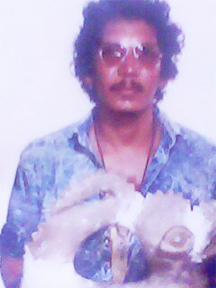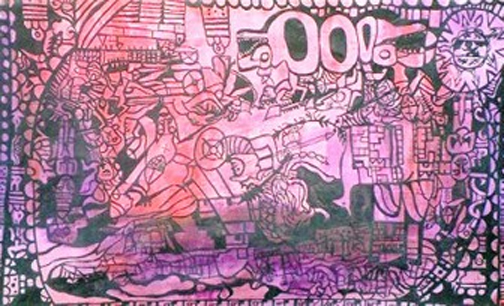Artist Desmond Alli feels that Guyanese have become “numb” and “immune” to injustices and therefore are mostly silent when these occur with only a few raising not very vigorous voices.
He said that lethargy has seeped into the world of visual artists in Guyana, who unlike their colleagues in other countries do not use their work to make statements about injustice, only producing pieces which are pleasing to the eye.
Alli, who is a sculptor, painter and Spanish teacher (he teaches privately), told Sunday Stabroek in a recent interview that he cannot sit idly by and not speak either through his art or the written word. For this, he said, he has been labelled an opposition member. But since he knew the late historian and politician Walter Rodney personally, and Rodney was killed at the height of his struggle against injustice, and since he has lived in colonial times and during the administrations of the PNC and the PPP/C, there was no way he could allow himself not to be sickened by the code of silence that has infected most of the population.

“Let me tell you something about Guyanese painters, in as much as people talk about the banning of calypsos because of its content, Guyanese artists I figure are not free to express themselves because of the market,” Alli said in the interview.
Describing himself as a self-taught artist Alli said should artists do work that vividly expressed what is happening in Guyana then no one would buy the pieces because the society is not sufficiently open to support such work. As it is artists self-censor their work.
He said as an artist he feels he must do his duty by speaking out about the struggles of the Guyanese people.
“Guyanese society is one of duplicity; people see things that they know… [are] wrong but they don’t speak out against it. They behave as if it is right but this leads gradually to dehumanization of the individual because… the human potential is drawn out of him until something happens to him,” Alli said.
Art in resistance
And Alli will not remain silent as he will soon be launching a book titled Art Resistance, a work he said which was guided by his profound conviction that art has the power to promote positive change because it is “unadulterated, unfettered and free.”
“And in a Guyanese context it can be used as an instrument of National Reconciliation,” Alli wrote in his book, which will be available in English, Spanish and Portuguese.
The artist said the younger generation needs to understand that there must be change in the society adding that “I am not taking a position anti-government or pro-opposition; I am just an artist…”
He recalled that he was recently speaking to a friend explaining that he does not support the government or the opposition, but rather he is a member of civil society. The friend responded that “there is no such thing like civil society because civil society is just an appendix for the government or the opposition.”
Alli said he understands the struggles of his colleagues who depend on their skills for a living and as such would not want to go outside of the box, but he also makes a living by teaching so refuses to censor himself in the area of expressing his feelings.
He said the book is a collection of his work in photographic form over a period of twenty-five years, but also includes the work of artists from the Guyana United Artists over a period of 50 years and also a few pieces from artists in Latin America.

According to Alli the works represent a chronological history of the Americas and the Caribbean in the creative arts of painting and sculpture. They include the pre-Colombian period and the periods which followed, including the Atlantic slave trade, the independence struggle, and “more importantly within our context, the Guyanese working class struggle.”
The book looks at Guyana from the years 1600 to 1838 and pays tribute to a number of the enslaved including Cuffy − leader of the 1763 Berbice Uprising − and then moves on to the pre-colonial and post-colonial periods up to 2011. Each photograph is accompanied by written descriptions of the periods they represent and the story behind them.
Alli named the post-colonial chapter the ‘The Great Betrayal’ as he recalled political leaders in the past told the populace that with the departure of the colonial masters the country would become the breadbasket of the region: “But forty-seven years after independence we have seen Guyana relegated to the third poorest country of the region…”
There is a piece dedicated to Sheema Mangar, the bank worker who was killed after being dragged by a car driven by a man who had just stolen her Blackberry, and the hundreds of Guyanese who were murdered by marauding criminal gangs and the phantom squad, or killed by the Guyana Police Force.
“Now people in Guyana want justice, they don’t want vengeance, they want justice and this is what this (pointing to one of his paintings in the book) is all about,” Alli said.
Alli’s new book is expected to have 80 pages in colour and 84 in black and white, and he hopes to launch it later at the Federal University in Roraima, Brazil followed by a launch in Guyana later. He knows that he will receive no sponsorship in Guyana for the book, but he said it will be available at a cost of about $2,000.
Through the book Alli said he hopes that people, especially the young in society, would recognize that art is “not only a functional and utility piece of something that is beautiful, but that art can be used correctionally, historically… it can be used to correct a situation.”
“Now the artist can portray and bring vividly to you a picture and he can show [that] if you understand comprehensively what’s going on here you can retrace the steps and do better. So the whole idea is in the absence of hav[ing] a great lot of historians writing about this period, I am just trying to bring something vividly visual that people can be able to understand and appreciate, so that we can move forward and carry the country,” Alli said.
He observed that while the country has vast potential it is in a political stalemate and this has kept it stagnated, while other countries − even those with whom it shares borders − are moving ahead.

Alli said while not ‘knocking’ the current leaders, he feels that there are not enough persons in leadership positions with vision, and mediocrity is the thing of the day as “partisan party politics is putting people in positions who don’t have the intellect, commitment, conviction and a vision to carry the country forward.”
In the book Alli also has pictures of the interior trails, and also photographs of some of the main cities in the Americas, as he noted many young people do not know of the countries in the Americas.
Alli, who left the country at an early age but later returned, said many persons try to “mystify” art, but for him it came as the result of history and he has seen the struggles of people throughout Latin America, and artists in those countries playing very active roles in the struggle for “bread and justice.”
He said the artists and the academic community in Guyana are dormant as it relates to these issues.
Alli, 57, became interested in art when he experienced the first Carifesta, which was hosted in Guyana in 1972. Pieces by sculptor Philip Moore, who is honoured in the book, made an “indelible impression” on him. However, it was when he moved to Brazil at the age of 17 that he found his style.

Spending five years in Brazil and two years in Argentina, Peru, Bolivia and other South American countries, Alli studied their history, which is reflected in his work. “Living in Latin America, I became familiar with the history of the country as well as the architecture as well as the culture of the people,” he stated.




